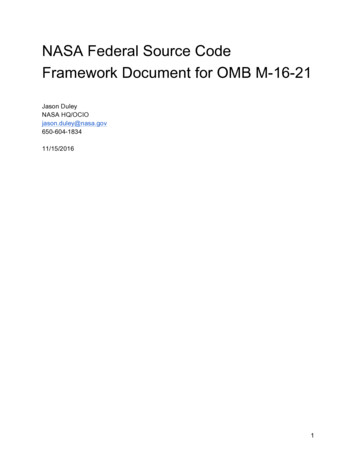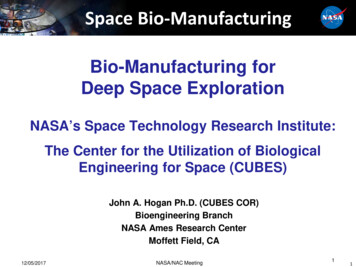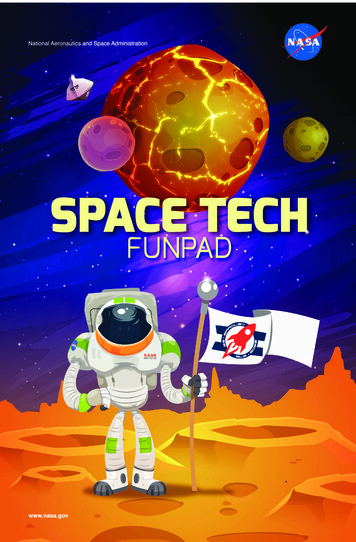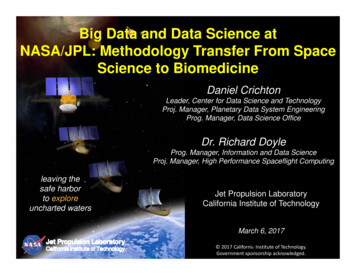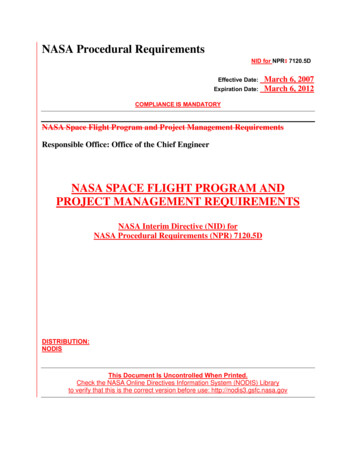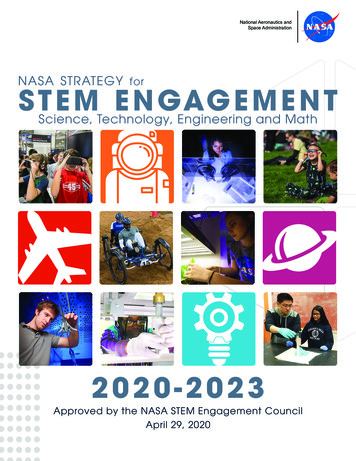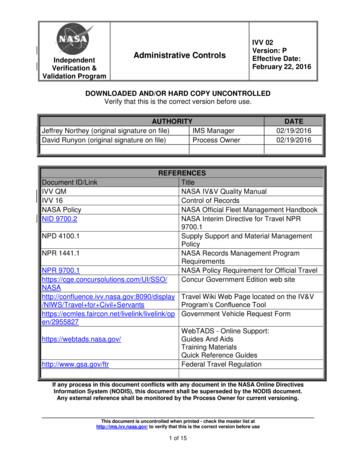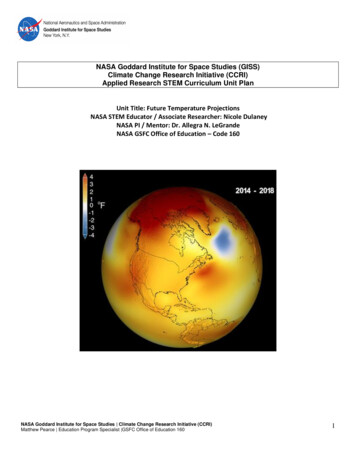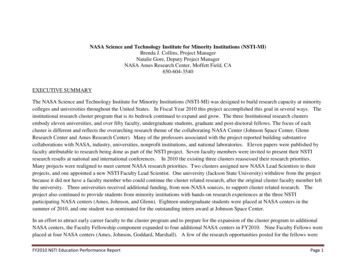
Transcription
NASA Science and Technology Institute for Minority Institutions (NSTI-MI)Brenda J. Collins, Project ManagerNatalie Gore, Deputy Project ManagerNASA Ames Research Center, Moffett Field, CA650-604-3540EXECUTIVE SUMMARYThe NASA Science and Technology Institute for Minority Institutions (NSTI-MI) was designed to build research capacity at minoritycolleges and universities throughout the United States. In Fiscal Year 2010 this project accomplished this goal in several ways. Theinstitutional research cluster program that is its bedrock continued to expand and grow. The three Institutional research clustersembody eleven universities, and over fifty faculty, undergraduate students, graduate and post-doctoral fellows. The focus of eachcluster is different and reflects the overarching research theme of the collaborating NASA Center (Johnson Space Center, GlennResearch Center and Ames Research Center). Many of the professors associated with the project reported building substantivecollaborations with NASA, industry, universities, nonprofit institutions, and national laboratories. Eleven papers were published byfaculty attributable to research being done as part of the NSTI project. Seven faculty members were invited to present their NSTIresearch results at national and international conferences. In 2010 the existing three clusters reassessed their research priorities.Many projects were realigned to meet current NASA research priorities. Two clusters assigned new NASA Lead Scientists to theirprojects, and one appointed a new NSTI Faculty Lead Scientist. One university (Jackson State University) withdrew from the projectbecause it did not have a faculty member who could continue the cluster related research, after the original cluster faculty member leftthe university. Three universities received additional funding, from non-NASA sources, to support cluster related research. Theproject also continued to provide students from minority institutions with hands-on research experiences at the three NSTIparticipating NASA centers (Ames, Johnson, and Glenn). Eighteen undergraduate students were placed at NASA centers in thesummer of 2010, and one student was nominated for the outstanding intern award at Johnson Space Center.In an effort to attract early career faculty to the cluster program and to prepare for the expansion of the cluster program to additionalNASA centers, the Faculty Fellowship component expanded to four additional NASA centers in FY2010. Nine Faculty Fellows wereplaced at four NASA centers (Ames, Johnson, Goddard, Marshall). A few of the research opportunities posted for the fellows wereFY2010 NSTI Education Performance ReportPage 1
further developed, and were subsequently placed in a new solicitation to expand the cluster project to other NASA centers anduniversities. This solicitation will be available for proposals in early 2011.PROJECT DESCRIPTIONThe NASA Science and Technology Institute for Minority Institutions (NSTI-MI) was established in 2006 to provide leading-edgeresearch opportunities for faculty and students from MIs that complement NASA's research programs and make original contributionsto NASA in astrobiology, biotechnology, information technology, energy, environment research, and other emerging technologies.NSTI-MI brings together the talent and expertise of MIs to communicate, connect, and collaborate with government, the privatesector, one another, and majority institutions through the establishment of R&D collaborations and partnerships. By placing MIswithin this nexus of business and intellectual property transfer networks, NSTI-MI aims to: stimulate cross-disciplinary research;improve the transfer of information ideas and technology; promote the development of market-based technologies; foster technologymanagement strategies that will move advances from scientific discovery to basic and applied technology; and establish educationalframeworks and networks that will continue to expand the Nation’s talent base for research and development.The first institutional cluster was located at Ames Research Center. In calendar year 2008, the NSTI-MI project was expanded into anOffice of Education national project with new research clusters placed at Glenn Research Center and Johnson Space Center. Eachcluster receives 250,000.00 to support its research goals, and is allotted two graduate fellows and one post-doctoral fellow. Thegraduate fellows are students at cluster universities and spend a majority of their time working at the university on cluster relatedresearch. The post-doctoral fellows spend one hundred percent of their time supporting cluster research activities at the NASA centerassociated with a cluster project. The NSTI project currently has three active clusters:UNCFSP-NSTI Information and Emerging Technologies Cluster (UNITE) conducts research that addresses pressing challengesin the areas of Supercomputing, Networking and Intelligent Systems. This Cluster also engages in nano-scale research to supportAerospace and Thermal Protection Systems as well as human exploration of space. UNITE institutions are listed below:Information and Emerging Technologies Trust (UNITE)-Ames (ARC)San Francisco State UniversityFY2010 NSTI Education Performance ReportPage 2
Texas Southern University (Norfolk University is a sub-contractor)California State University- FullertonSouthern UniversityTuskegee UniversityUNCFSP-NSTI Mission Enabling Technologies Cluster (UNIMET) conducts human exploration missions enabling research in theareas of Science Missions Payloads, Biotechnology, Astrobiology, Human Factors, Advanced Life Support and Bio-nanotechnology.UNIMET Institutions are listed below:Mission Enabling Technologies Trust (UNIMET) –Johnson (JSC)Jackson StateUniversity of TexasSouthern UniversitySavannah State UniversityJarvis Christian CollegeTougaloo CollegeUNCFSP-NSTI Energy and Environmental Cluster (UNEEC) addresses energy and environmental issues as it relates to spacetravel and life on earth. UNEEC institutions are listed below:FY2010 NSTI Education Performance ReportPage 3
Energy and Environmental Trust (UNEEC) –Glenn (GRC)Savannah State UniversityUniversity of Texas at El PasoWilberforce University TexasSouthern UniversityThe program has also grown to include two additional components beyond the institutional research clusters. The other componentsof the NSTI Project are the Summer Scholars Program and the NSTI Summer Faculty Fellowship Program. The Summer Scholarsprogram offers undergraduate students 10 week internships at the three NASA centers associated with the NSTI Cluster project(Ames, Johnson, and Glenn). Students must have at least a 3.0 grade point average, and attend a minority serving institution to beeligible for this program. The internship pays a small stipend of 7000.00. The 2010 interns were the program’s fifth cohort.The NSTI Summer Faculty Fellowship project targets early career faculty from minority serving institutions. The faculty mustidentify a NASA host for their proposed project and create a detailed research plan for their summer activities. The fellowship is a10week hands on research experience and occurs in conjunction with the NSTI Summer Scholars Project. Faculty members receive astipend of 13,500.00 for the 10 week research experience. This project started in 2009 and all fellows were located at NASA Amesresearch center that year. In 2010 this project was offered to all centers. However, only three additional NASA centers actuallyaccepted faculty fellows in 2010. The other NASA centers chose not to participate.The NSTI-MI is currently administered by the United Negro College Fund Special Programs Corporation (UNCFSP) through acooperative agreement and managed by NASA Ames Research Center’s Office of Education.PROJECT GOALSNSTI-MI focuses its efforts to meet the goals and objectives listed below:FY2010 NSTI Education Performance ReportPage 4
Goal 1: Link Minority institutions, industry, non-profits, and other entities through close association and alignment of researchinterests and expertise to create symbiotic partnerships.Goal 2: Channel R&D efforts toward the development of market-based concepts that can be leveraged for sustainability.Goal 3: Provide professional development, including research, business acumen, and leadership building expertise that will groom andprepare faculty, students, and others to be highly-skilled science and technology leaders and managers.Goal 4: Work with Key Stakeholders to perform the following: Select students through a competitive application process to increase their STEM awareness and knowledge throughindividual experiential opportunities Select faculty at minority institutions through competitive application processes to engage in collaborative research andincrease their awareness and knowledge of NASA disciplines and missions Select minority-serving institutions participating in the NSTI Cluster project through competitive application processes toincrease their research capability and capacity for competitiveness for mainstream research and development awards.NSTI-MI accomplishes its goals through the formation of research clusters that include faculty, students, post-doctoral fellows andcollaborates with NASA scientist/engineers, majority institutions and the private sector to engage in NASA-related research anddevelopment. NSTI-MI research clusters provide excellent leadership opportunity for faculty from MI’s to lead research teams andassist member institutions in competing for new research grants and/or contracts. NSTI-MI provides professional developmenttraining in R&D leadership and development, project management, business development, marketing and contract management.NSTI-MI is committed to STEM workforce development. It provides fellowship and internship opportunities for undergraduate andgraduate students in NASA related programs and activities.PROJECT BENEFIT TO OUTCOMESAll NSTI-MI goals and objectives are designed to support the Agency Strategic Plan and Education goals. NSTI-MI supports fiveobjectives under Education Outcomes 1: Contribute to the development of the STEM workforce in disciplines needed to achieveNASA’s Strategic goals through a portfolio of investments.FY2010 NSTI Education Performance ReportPage 5
Objective 1.1- Faculty and Research Supporto Provide NASA competency-based education and Research opportunities for faculty, researchers and post-doctoral fellows.Objective 1.2- Student Supporto Provide NASA competency-building education and research opportunities to individuals in order to develop qualifiedundergraduate and graduate students who are prepared for employment in STEM disciplines at NASA, industry or highereducation institutions.Objective 1.3 -Student Involvemento Provide opportunities for groups of post-secondary students to engage in authentic NASA-related mission-based researchand development activities.Objective 1.4- Course Developmento Develop NASA-related course resources for integration into STEM disciplines.Objective 1.5- Targeted Institution Research and Academic Infrastructure Supporto Improve the ability of target institutions to compete for NASA research and development work.The NSTI project met all five objectives in FY2010. NSTI met Objective 1.1: Faculty and Research Support and Objective 1.2:Student Support through its Faculty Fellowship, Summer Scholars and UNCFSP Graduate Fellows programs. In FY2010 nine fellowswere accepted into the Faculty Fellowship project. These fellows worked at four different NASA centers. Since 2009, a total ofsixteen Faculty Fellows have been provided the opportunity to collaborate with NASA scientists and technologists. One 2009 NSTIFaculty Fellow was selected by Goddard Space Flight Center to be a 2010 NSTI Faculty Fellow. Another 2009 Faculty Fellow wasfunded directly by the NASA host he collaborated with in the summer of 2009, to continue his research at NASA Ames ResearchCenter for a second year in FY2010. Eighteen undergraduate scholars were selected for the 10 week Summer Scholar Researchopportunity. Since 2006, seventy-seven NSTI Summer Scholars have been provided internship opportunities and sixty-nine studentshave graduated with STEM degrees. Three graduate fellows were also hired to work at a NSTI associated university in FY2010. Oneof the 2010 UNCFSP Graduate Fellows, selected to support research being done at the University of Texas, El Paso, received herPh.D. degree. She is now working at a start-up company that was created to commercialize materials developed as a result of herNSTI related research.FY2010 NSTI Education Performance ReportPage 6
The project supports Objective 1.3-Student Involvement by providing hands on research opportunities to students located at one of thecluster schools. In 2010, three NSTI faculty members reported that they provided students the opportunity to work on cluster relatedresearch at their universities.The project supports Objective 1.4: Course Development and Objective 1.5-Targeted Institution research and academic infrastructuresupport directly through the NSTI Institutional Cluster portion of the project. The NSTI project provided funding to eleven minorityserving institutions, three located in Experimental Program to Stimulate Competitive Research (EPSCoR) States. The universitiesreported using NSTI funding to expand research capacity, create or redesign courses, and provide hands-on NASA content relatedresearch opportunities to students and graduate fellows. Three universities indicated that they have received additional non-NASAfunding to support research activities at their universities.Overall this project is meeting the goals that its designers envisioned. It is building research capacity at minority institutionsproviding research opportunities for students and faculty. It has built research infrastructure at the university by providing the seedmoney that allowed many of the researchers to seek additional funding or work collaboratively with other universities and nationallaboratories. FY2010 was the year that this project truly began to produce meaningful long term results for the NASA educationportfolio.PROJECT ACCOMPLISHMENTSFor the period: October 1, 2009 through September 30, 2010NSTI Summer Faculty Fellowship ProjectThe Summer Faculty Fellowship was successfully expanded to include more centers this year. All centers were offered theopportunity to host Faculty Fellows, but only three centers were actually available to participate in FY2010. This year’s summerfaculty fellows were placed at Ames, Johnson, Marshall and Goddard. Ames and Marshall hosted three faculty fellows, Johnsonhosted one fellow, and Goddard hosted two fellows in 2010. This year’s cohort included many accomplished scientists andtechnologists who came with many accolades and accomplishments. Among the notables were Michael Watson of Fisk Universitywho is the Coordinator for Tennessee Space Grant Consortium at his University; and Yousef Hijji of Morgan State University whowas presented the 2009 Morgan State University Dean’s Outstanding Researcher Award.FY2010 NSTI Education Performance ReportPage 7
The NSTI Faculty Fellowship accomplished all if its goals this year, especially Objective 1.1: faculty and research support. Itexpanded to three additional centers, providing a wider array of research opportunities for the 2010 Fellows. It also helped tobuild a strong bridge of collaboration between the NASA research community and faculty from minority institutions, asevidenced by the fellows own words: “My NASA host was extremely helpful and supportive of me throughout the entire fellowship. He gave me the freedom toexplore and express my skills and talents to my proposed research plan. He added a great deal of his own experience as aresearcher and research mentor to enhance my summer experience.” – Dr. Carla Cotwright Williams, Norfolk StateUniversity “This (NSTI Faculty Fellowship Project) is a great opportunity for MIs to encourage faculty to conduct high-graderesearch.” - Dr. Ehsan Sheybani,Ph.D. “The NSTI Faculty Fellowship served to strengthen the relationship between Fisk and NASA.” - Dr. Michael Watson, FiskUniversity “My research project when applied into the curriculum will provide students some knowledge, methods and techniques ofanalysis that will open their eyes to the importance of space research and get excited about what is available on otherplanets or moons.”- Dr. Yousef Hijji, Morgan State UniversityOther accomplishments were: In 2010 thirty-three percent of the faculty fellows were from minority institutions universities in EPSCoR states Inspired by her NSTI Faculty Fellowship experience, Carla Cotwright Williams, Ph.D. signed up to participate with theCollege of Sciences and Departmental Activities at Norfolk University to promote student and faculty participationwith NASA. (UNCFSP 2011)FY2010 NSTI Education Performance ReportPage 8
The summer research experienced by Zhengtao Deng, Ph.D at NASA prepared him to continue the research inshockwave control at Alabama A &M University (AAMU). A notable activity for the university in 2010 was theinstallation of a supersonic wind tunnel in September 2010.(UNCFSP 2011)NSTI Summer Scholars Program. 18 Scholars were placed at three different NASA Centers. A more streamlined selection process assured that all of theappropriated slots for the NSTI program were filled with qualified candidates from underrepresented and underservedcommunities. To date the program has provided internship opportunities to 77 students, 69 of whom have graduated with STEM-relateddegrees. (UNCFSP 2010) One 2010 intern, Cleveland Savage, was nominated by his mentor for the 2010 Johnson Space Center Intern of the YearAward. (Johnson Department of Education 2010) At least twenty eight percent of the students were from EPSCoR states. The Application process for the Summer Scholars program was migrated to the new OSSI/Solar System. All FY2011candidates will apply to NSTI using the new system.NSTI Cluster ProjectUNCFSP hosted the first annual Business Meeting with the three Clusters which provided an opportunity for Cluster representatives tohave an open dialogue with the UNCFSP management and NASA program management to discuss project activities, and present thestatus of their research. All clusters were able to advance their research projects towards the goal of aligning the projects withNASA’s mission while providing opportunities for students and other faculty to engage in STEM-related research. In 2010 two of thethree cluster projects made great strides in meeting their graduate student requirements. Three graduate fellows and two post doctoralfellows were hired through UNCFSP to support the cluster projects. Three universities (Savannah State University, Jarvis ChristianUniversity, and the University of Texas El Paso) reported receiving additional funding for their NSTI related research in excess ofFY2010 NSTI Education Performance ReportPage 9
350,000.00. Also many of the faculty representatives have reported that they have been able to provide undergraduate and othergraduate students (see below) quality research opportunities by providing them contact hours on cluster projects.o Cluster Accomplishmentso NSTI Cluster faculty and/or students published eleven papers. Examples follow:Author (S)YearS. Yanamandram andH. Shahnasser2010S. Kumar, H.Shahnasser, H. JingA. Hosseni Tehrani, H.Shahnasser2010Mbarika, V.,Bagarukayo, E.,Hingorani, V., Stokes,S., Kourouma, M. andSankar., C.L. Tiwari and H.201020102010TitleA theoretical scheme toimplement MAC protocols inVANETs employing cognitiveradioPodcasting in mobile WiMAX:A Case StudyAnonymous Communicationin MANETs Solutions andChallengesA Multi-Experimental Studyon the Use of MultimediaInstructional Materials toTeach Technical SubjectsExploiting Punctuations alongFY2010 NSTI Education Performance ltyFaculty/Page 10
ShahnasserA. Joshi and H.Shahnasser2010S. Yanamandram andH. Shahnasser2009G. Alonso-Nunez, R.Huirache-Acuna, F.Paraguay-Delgado, J.A.Lumbreras, R. GarciaAlamilla, A. CastilloMares, r. Romero, R.Somanathan and R.R.Chianelli2009R. Chianelli, G.Berhault, B. Torres2009with Sliding Windows toOptimize STREAM DataManagerA Qualitative Analysis andImprovement of Naïve BayesAlgorithm Using CrossValidation and DiscretizationAnalysis of DSRC based MACprotocols for VANETsUnsupported Transition MetalSulfide Catalysts: 100 years ofScience and ApplicationSynthesis andCharacterization ofHexamethylenediammoniumThiomettallates as Precursorsof MoS2 and WS2 Catalysts: InSitu Activation During HDS o UNNEC - UNCFSP-NSTI Energy and Environmental Cluster UNCFSP Graduate Fellow graduates and starts work in small start-up company UNCFSP Graduate Fellow, Dr. Karina Castillo, (representing the UNEEC Cluster at UTEP)successfully completed the Ph.D. Her work was the basis for a program at University of Texas, El Paso(UTEP) in collaboration with Hunt Energy. The program is in the process of becoming commercialized.(UNCFSP 2011)UNCFSP Post Doctorate Fellow hired by NASAFY2010 NSTI Education Performance ReportPage 11
UNCFSP Post-doctorate Fellow, Dr. Michael Kullis, (representing the UNEEC Cluster at GRC) willbegin employment as a Civil Servant with Glenn Research Center in February, 2011. (UNCFSP 2011)UTEP Faculty create partnerships to develop and commercialize UNNEC catalyst materials Dr. Chianelli at UTEP created partnerships with private companies, national laboratories and otheruniversities to develop and commercialize UNNEC catalyst materials. (Chianelli Biannual Report 2010)o UNIMET- UNCFSP-NSTI Mission Enabling Technologies Cluster Texas Southern Faculty Member presents research at International Conference Dr. Alamelu Sundaresan, NSTI UNIMET Cluster PI at Texas Southern University, was accepted topresent her research findings at the International Academy of Aerospace medicine forum in Singaporealong with four other co-authors from NASA (UNCFSP 2011) Dr. Karla Sue Marriott received the Early Career Award in Chemistry from the National Institute of Health.(UNCFSP 2011) Jarvis Christian College scientist collaborating with other university to work on UNIMET project Shakhawat Bhuiyan, Ph.D of Jarvis Christian College is collaborating with Dr. Christian Zwieb,Professor of Molecular biology, University of Texas Health Center at Tyler to develop the infrastructureto support high quality research at Jarvis Christian College. University of Texas provides Dr. Bhuiyanwith laboratory facilities for proposed UNIMET research activities and also for training students throughsummer research. He also reported that one undergraduate student is working with him in hisLaboratory on his UNIMET project. ( Bhuiyan Quarterly Report 2010)Texas Southern University provides research experience on UNIMET project to two students Alamelu Sundaresan of Texas Southern University has one undergraduate and one graduate studentworking on UNIMET Projects in her Laboratory this fiscal year. The undergraduate student graduatedwith a degree in biology (Sundaresen Quarterly Report 2010)FY2010 NSTI Education Performance ReportPage 12
Tougaloo College provides UNIMET related research experience two students Dr. Jinghe Mao of Tougaloo College has two undergraduate students working on her UNIMET project.One student graduated with a degree in Biology in May 2010. ( Mao Quarterly Report 2010)o UNITE- UNCFSP-NSTI Information and Emerging Technologies Cluster Texas Southern faculty develops new course Dr. Bobby Wilson, PI for the UNITE Cluster at Texas Southern University, and Dr. Renard Thomas,collaborator, developed a new course in Nanoscience in which 50 students (6-8 from 6 HBCU sites)participated. (UNCFSP 2011)Southern University faculty develops two new courses Victor Mbarika of Southern University developed two new courses: an undergraduate Introductory toInformation Technology course and a graduate overview of IT course. (Mbarika Biannual Report 2010) Southern University faculty provides research opportunities for students on cluster projectso Two students who worked on the project at Southern University in 2010. One was a graduate studentand the other an undergraduate student. The undergraduate student was the valedictorian for the spring2010 graduation. (Mbarika Biannual Report 2010) Led by Ames office of Education, the lead NASA center for the UNITE Cluster, cluster members in associationwith UNCFSP and the NSTI-NASA lead scientist for nano-technology research at Ames held a successfulmeeting in the fall of 2010 to re-organize the cluster. The new focus will be in bio-nanotechnology with aninteractive education componentPROJECT CONTRIBUTION TO PART MEASURESFor the period: October 1, 2009 through September 30, 2010FY2010 NSTI Education Performance ReportPage 13
Summer Faculty Fellowship Program Total Number of Participants (Cohort 2): 9Objective 1.1- Faculty and Research Support: 9Objective 1.5- Minority Institutions Represented: HBCU 78% (7); HSI 22% (2)Objective 1.5- The number of Minority Universities located in EPSCoR States: 3 (Tennessee, Puerto Rico, Alabama)NSTI Faculty Fellows were from three of the states identified as EPSCor States.NASA supports the mission of EPSCoR, and tries to ensure that EPSCor states are represented within the NASA educationportfolio. The mission of EPSCoR is to assist the National Science Foundation in its statutory function "to strengthen researchand education in science and engineering throughout the United States and to avoid undue concentration of such research andeducation." EPSCoR goals are:To provide strategic programs and opportunities for EPSCoR participants that stimulate sustainable improvementsin their R&D capacity and competitiveness.o To advance science and engineering capabilities in EPSCoR jurisdictions for discovery, innovation and overallknowledge-based prosperity.o To broaden participation in science and engineering by institutions, organizations and people within and amongEPSCoR jurisdictionsoFY2010 NSTI Education Performance ReportPage 14
Arab American11.1%Caucasian33.3%Asian22.2%African American0.0%33.3%10.0%20.0%30.0%40.0%Figure 1- NSTI Faculty Fellowship: Ethnicity of the ParticipantsThe faculty fellows represented a broad range of disciplines in FY2010. As figure 2 demonstrates, Engineers and Physicists were the areasof study most represented among faculty in FY2010.FY2010 NSTI Education Performance ReportPage 15
mputationalAstrophysicsMechanical EngineeringChemistryChemical EngineeringFigure 2- NSTI Faculty Fellowship: Technical Field of the ParticipantsSummer Scholars Program Objective 1.3-Total number participants reported FY10 (Cohort 5): 18Number of participants continuing in school: 18Number of participants from EPSCoR States: 5Objective 1.2: Underserved and Under-represented Students Ethnicity and GenderCohort 1Cohort 2Cohort 3Cohort 4Cohort 10 NSTI Education Performance ReportPage 16
Graduate5260 5MajorityInstitution73923Prior NASAExperience01324*The program was changed in 2009, only undergraduate students are eligible for this project.The number of males and females in the FY2010 Summer Scholars project were roughly equal. Males outnumbered females by 12%(Figure 3). However, in actual numbers there were only two more males represented among the NSTI Scholars than females. All ofthe males were from underrepresented populations. Six percent of the Cohort 5 were Asian. However, all Asians were fromunderserved communities (Figure 4).FY2010 NSTI Education Performance ReportPage 17
Female, 44%Male, 56%Figure 3- Cohort 5: GenderFY2010 NSTI Education Performance ReportPage 18
Hispanic,11.1%Asian, 5.6%AfricanAmerican,83.3%Figure 4- Cohort 5: EthnicityUnderrepresented and underserved students from majority institutions were selected for the FY2010 Summer Scholars program(Figure 5). The administrator of the program, UNCFSP, requested that these students be allowed to participate, due to the lack ofqualified candidates from minority institutions in their internal application pool. The hope is that this will be remedied when theproject is migrated into the new NASA OSSI/SOLAR application system in FY2011.FY2010 NSTI Education Performance ReportPage 19
121086420MajorityUniversitiesHistoricallyBlack Collegesand UniversitiesHispanic ServingInstitutionsFigure 5- Institution TypeA majority of the students who were selected in FY2010 were engineering and biology majors (Figure 6).FY2010 NSTI Education Performance ReportPage 20
ComputerScience, 7%Physics,7%Math, 13%Engineering,33%Biology, 27%Chemistry,13%Figure 6- Cohort 5: Undergraduate Degrees SoughtNSTI Cluster ProgramNumber of Clusters: 3Objective 1.5- Minority Institutions Participating: 11 San Francisco State UniversityCalifornia State University-FullertonTexas Southern University (in 3 Clusters)University of Texas-El Paso, Tuskegee UniversitySavannah State University (in 2 Clusters)Tougaloo CollegeFY2010 NSTI Education Performance ReportPage 21
Jackson State University (Withdrew 2010: cluster faculty left the university)Jarvis Christian CollegeSouthern University A& M UniversityWiberforce UniversityNorfolk State University (sub-contractor to Texas Southern University- UNITE Cluster)Objective 1.5- Number of Institutions located in EPSCoR States: 3 (one in Louisiana; two in Mississippi)Total Number of NASA Centers Participating: 3 (Ames, JSC, GRC)Objective 1.2-Number of Students c
NASA Science and Technology Institute for Minority Institutions (NSTI -MI) Brenda J. Collins, Project Manager . Natalie Gore, Deputy Project Manager . NASA Ames Research Center, Moffett Field, CA . 650-604-3540 . The NASA Science and Technology Institute for Minority Institutions (NSTI-MI) was designed to build research capacity at minority
